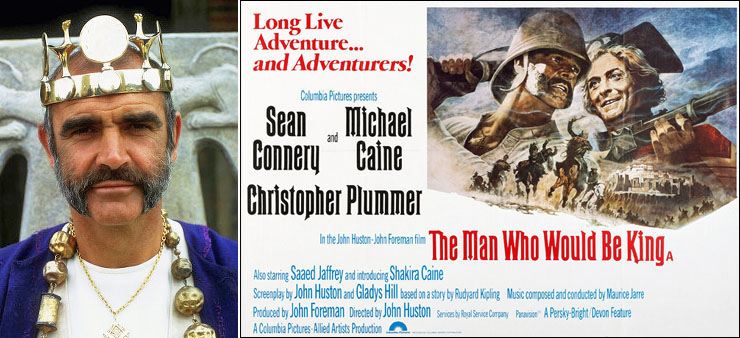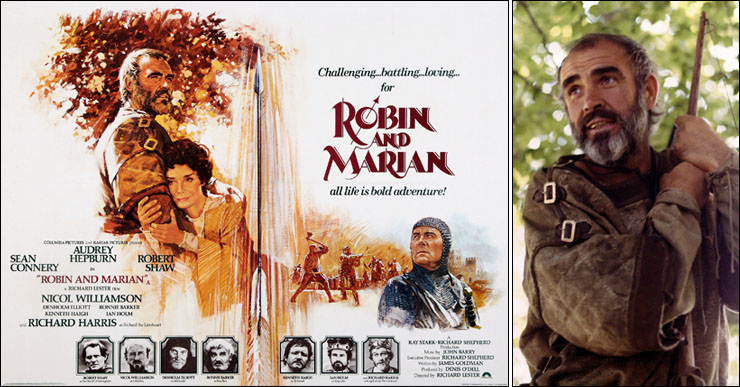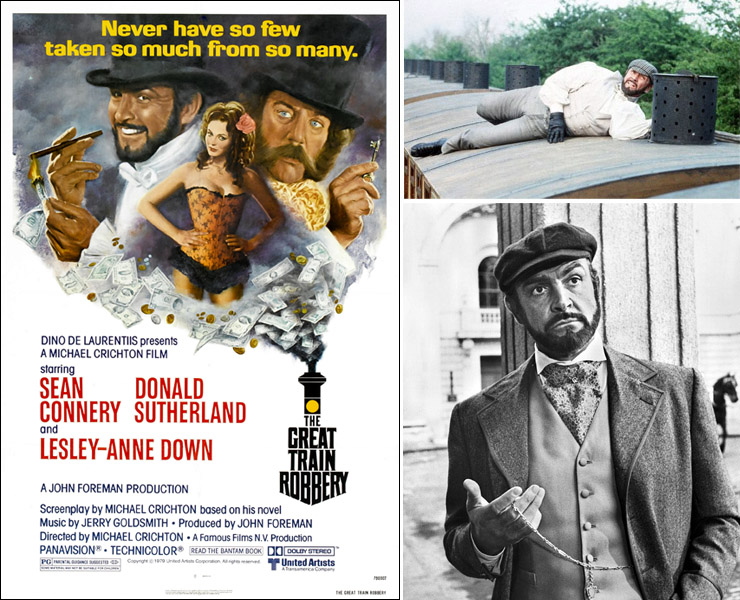JAMES BOND
|
||
|
||
JAMES BOND
|
||
|
||
|
||||
|
Part 4: The Man Who
Would Be King |
||||
|
|
||||
|
Sean Connery followed The Wind And The Lion with another signature role in The Man Who Would Be King (1975). Adapted and directed by John Huston from Rudyard Kipling's 1888 novella, The Man Who Would Be King was a project he had been trying to film since the 1950s, originally with Clark Gable and Humphrey Bogart, and later Burt Lancaster and Kirk Douglas as the two leads. In the 1960s Richard Burton and Peter O'Toole were considered, and finally Huston approached Robert Redford and Paul Newman following their success in Butch Cassidy And The Sundance Kid (1969). Newman advised Huston that British actors should play the roles, and it was he who recommended Sean Connery and Michael Caine. This casting was inspired and the two leads played off each other memorably as rogue ex-soldiers, who set off from nineteenth-century British India in search of adventure. Daniel Dravot (Connery) and Peachy Carnehan (Caine) end up in remote Kafiristan, where one is taken for a god and made their king. Both actors later claimed that The Man Who Would Be King was the favourite of all the films they had made in their long careers. Connery and Caine remained good friends although they never appeared on film again together (they did both star in A Bridge Too Far in 1977 but shared no scenes). The Man Who Would Be King would prove to be another box-office triumph. |
||||
 |
||||
|
In 1976 Sean Connery then took on the lead role as the ageing Robin Hood in Richard Lester's Robin and Marian, co-starring opposite Hollywood legend Audrey Hepburn, in her first film in almost a decade. Robin and Marian reunited Sean Connery with Robert Shaw (playing the Sheriff of Nottingham), and the two have a memorable fight scene at the climax of the film. Other roles were filled by many notable British character actors including Nicol Williamson (as Little John), Denholm Elliott (as Will Scarlet), and comedian Ronnie Barker as Friar Tuck. Connery was also reunited with his Molly Maguires co-star Richard Harris, who played Richard The Lionheart. With a witty script by James Goldman and an exceptional score by John Barry, Robin and Marian was another box-office winner and marked Sean Connery's third back-to-back international hit in what was perhaps the most successful stage in his career outside the James Bond films. Ironically, Sean Connery's son Jason also played Robin Hood in the 1986 TV-series Robin of Sherwood, replacing Michael Praed at the end of the third season. |
||||
 |
||||
|
Following his three historical adventure films, Sean Connery then starred in the American political thriller The Next Man (1976) [also known as The Arab Conspiracy or Double Hit], in which he was somewhat miscast as a Saudi Arabian Minister of State. Set during the Arab oil embargo of 1973-1974, The Next Man was not very well received by critics at the time of its release. For James Bond fans the film is notable for also featuring Adolfo Celi (Largo in Thunderball), and having its main titles designed by Maurice Binder. The film also featured the debut score of composer Michael Kamen, who would later provide the music for Licence To Kill in 1989. Sean Connery next took on the role of Major-General Roy Urquhart in Richard Attenborough's all-star epic A Bridge Too Far (1977). The film tells the story of the failure of Operation Market Garden during World War II, when the Allies attempt to seize several bridges in occupied Holland in the hope of breaking the German lines. Connery had the stand-out performance in the star-studded cast, having one of the larger roles and appearing throughout the three-hour film. |
||||
|
||||
|
1979 saw Connery star in three very different films with varying degrees of success. Cuba saw him reunited with Richard Lester to play Major Robert Dapes, a British mercenary who arrives in pre-Revolution Cuba to help train General Batista's Army against Castro's guerrillas. He also romances a former lover (played by Brooke Adams) now married to an unscrupulous plantation owner. The film was a box-office disappointment but saw Connery reunited with Denholm Elliott (Robin and Marian) and Martin Balsam (The Anderson Tapes), Executive producer Denis O'Dell had also produced The Offence in 1972. The film is notable for having poster artwork designed by Richard Amsel (1947-1985) which shows Connery in a Bond-like pose surrounded by bikinied lovelies. Cuba was followed by the starring role in Meteor (1979), a science-fiction thriller made at the end of the 1970s disaster cycle. The film proved to be a disaster in every sense of the word. Despite its all-star cast including Henry Fonda, Natalie Wood and Trevor Howard, Meteor had a $16-million budget, but reused footage from the 1978 disaster film Avalanche. The film recouped less than half of its production costs and was one of the biggest box-office flops in Hollywood history. |
||||
 |
||||
|
Sean Connery redeemed himself somewhat in his final film of the decade The Great Train Robbery (1979) [known in the UK as The First Great Train Robbery and released in December 1978, six weeks ahead of the US opening], co-starring with Donald Sutherland in Michael Crichton's historical thriller which the director had adapted from his own novel. Connery plays Edward Pierce, a charismatic member of upper-class Victorian London society, who also happens to be a master thief. Sean Connery performed most of his own stunts in the film, including the extended sequence on top of a moving steam train as part of the gold bullion robbery. The sequence proved incredibly dangerous, as the 48-year-old Connery was told that the train could only travel at 20 miles-per-hour, when in fact it was moving at closer to 50 mph! Proving adept at light comedy, Connery and Sutherland play well against each other, ably supported by Lesley-Anne Down. The film also boasted another memorable score from Jerry Goldsmith and proved to be a hit at the box-office, grossing $13-million against a budget of $7-million. |
||||
|
||||
|
As he reached his half century, Sean Connery took on fewer film roles in the 1980s, but it would be the spectre of James Bond that came back to haunt him once again. In 1976 he had begun developing a screenplay along with author Len Deighton and Thunderball copyright holder Kevin McClory entitled ‘James Bond of the Secret Service’. With no intention of actually playing 007 again, the project was worked on by the threesome and eventually a screenplay entitled ‘Warhead’ was ready for production. |